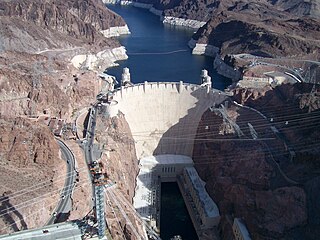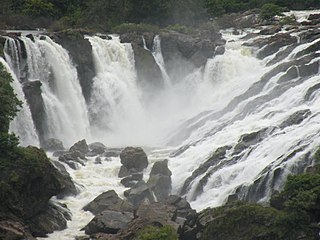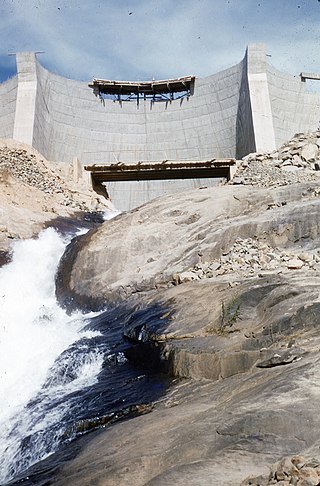
Hydroelectricity, or hydroelectric power, is electricity generated from hydropower. Hydropower supplies one sixth of the world's electricity, almost 4500 TWh in 2020, which is more than all other renewable sources combined and also more than nuclear power. Hydropower can provide large amounts of low-carbon electricity on demand, making it a key element for creating secure and clean electricity supply systems. A hydroelectric power station that has a dam and reservoir is a flexible source, since the amount of electricity produced can be increased or decreased in seconds or minutes in response to varying electricity demand. Once a hydroelectric complex is constructed, it produces no direct waste, and almost always emits considerably less greenhouse gas than fossil fuel-powered energy plants. However, when constructed in lowland rainforest areas, where part of the forest is inundated, substantial amounts of greenhouse gases may be emitted.

An underground power station is a type of hydroelectric power station constructed by excavating the major components from rock, rather than the more common surface-based construction methods.

The Koyna River is a tributary of the Krishna River which originates in Mahableshwar, Satara district, western Maharashtra, India. It rises near Mahabaleshwar, a famous hill station in the Western Ghats. Unlike most of the other rivers in Maharashtra which flow East-West direction, the Koyna river flows in North-South direction. The Koyna River is famous for the Koyna Dam and the Koyna Hydroelectric Project. Koyna Hydroelectric Project is the 2nd largest completed hydroelectric project in India. The reservoir – Shivasagar Lake, is a huge lake of 50 km in length.

The Robert Moses Niagara Hydroelectric Power Station is a hydroelectric power station in Lewiston, New York, near Niagara Falls. Owned and operated by the New York Power Authority (NYPA), the plant diverts water from the Niagara River above Niagara Falls and returns the water into the lower portion of the river near Lake Ontario. It uses 13 generators at an installed capacity of 2,525 MW (3,386,000 hp).

The Mania River is a river in Madagascar that flows from the central mountains of the island, emptying into the Mozambique Channel. The region of Amoron'i Mania is named from this river.
Anjiajia is a town and commune in Madagascar. It belongs to the district of Ambato-Boeni, which is a part of Boeny Region. The population of the commune was estimated to be approximately 13,000 in the 2001 commune census.

The Mulwala Canal is an irrigation canal in the southern Riverina region of New South Wales, Australia. It is the largest irrigation canal in the Southern Hemisphere. The canal, starting at Lake Mulwala, diverts water from the Murray River across the southern Riverina plain to the Edward River at Deniliquin. The canal is 156 km long. The channel has an offtake capacity of 10,000 megalitres (ML) per day and annually supplies over 1,000,000 ML to 700,000 hectares in the Murray Irrigation Area.

The Samanala Dam is a dam primarily used for hydroelectric power generation in Sri Lanka. Commissioned in 1992, the Samanalawewa Project is the third-largest hydroelectric scheme in the country, producing 405 GWh of energy annually. It was built with financial support from Japan and the United Kingdom. It is notable for a large leak on its right bank. Power production continues as planned despite the leakage, and the water from the leak now provides two thirds of the water issued by the reservoir for agriculture in downstream areas.

Hydroelectricity is, as of 2019, the second-largest renewable source of energy in both generation and nominal capacity in the United States. In 2021, hydroelectric power produced 31.5% of the total renewable electricity, and 6.3% of the total U.S. electricity.

India is 5th globally for installed hydroelectric power capacity. As of 31 March 2020, India's installed utility-scale hydroelectric capacity was 46,000 MW, or 12.3% of its total utility power generation capacity. Additional smaller hydroelectric power units with a total capacity of 4,683 MW have been installed. India's hydroelectric power potential is estimated at 148,700 MW at 60% load factor. In the fiscal year 2019–20, the total hydroelectric power generated in India was 156 TWh with an average capacity factor of 38.71%.
The Dharasu Power Station is a run-of-the-river hydroelectric power station on the Bhagirathi River located at Dharasu in Uttarkashi district, Uttarakhand, India. The power station was commissioned in 2008 and has a 304 MW capacity.
Mantasoa Dam is a buttress dam on the Varahina-North River, a tributary of the Ikopa River, near Mantasoa in the Analamanga Region of Madagascar. The dam was constructed by French contractors between 1937 and 1938. It creates Lake Mantasoa which has a surface area of 20 km2 (7.7 sq mi). The dam itself is made of 8,000 m3 (10,000 cu yd) of concrete and has a reinforced buttress design. Water released from the dam supplies a regulated flow to hydroelectric power station at the Antelomita Dams downstream. A saddle dam on the north side of the Mantosoa reservoir regulates water flow into the Mandraka River for the Mandraka Dam downstream.

The Tsiazompaniry Dam is a buttress dam on the Varahina-South River, a tributary of the Ikopa River, near Tsiazompaniry in the Analamanga Region of Madagascar. The dam was constructed by a French firm in 1956. It creates Lake Tsiazompaniry, the largest reservoir in the country, which has a surface area of 31 km2 (12 sq mi) and a storage volume of 260,000,000 m3 (210,000 acre⋅ft). A second buttress dam, 1 km (0.62 mi) northwest of the main dam helps withhold the reservoir. Water released from the dam supplies a regulated flow to hydroelectric power station at the Antelomita Dam downstream. Efforts to install a 5.25 MW power station at the base of the dam began in 2011.

Boʻstonliq is a district of Tashkent Region in Uzbekistan. The capital lies at the city Gʻazalkent. It has an area of 4,930 km2 (1,900 sq mi) and it had 171,200 inhabitants in 2021.
Nkusi Hydroelectric Power Station, also referred to as Nkusi Power Station, is a 9.6 MW (12,900 hp) hydroelectric power station in the Western Region of Uganda.
Sahofika Hydroelectric Power Station, also referred to as Sahofika Power Station, is a 205 megawatts (275,000 hp) hydroelectric power station under construction in Madagascar.
The Volobe Power Station is a proposed 120 megawatts (160,000 hp) hydroelectric power project in Madagascar. The project is owned and is under development by a consortium comprising (a) Jovena, a subsidiary of the Axian Group (b) SN Power of Norway (c) Africa50 and (d) Colas Madagascar. The 750 GWh of clean energy generated here annually will be sold directly to Jirama, the national electricity utility company under a 35 year power purchase agreement (PPA).












